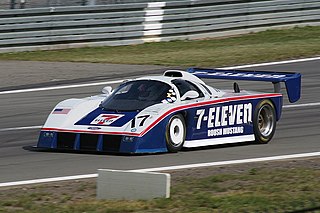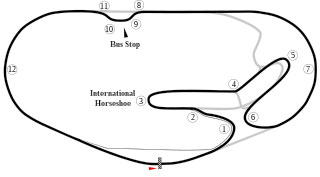Related Research Articles
The International Motor Sports Association (IMSA) is a North American sports car racing sanctioning body based in Daytona Beach, Florida under the jurisdiction of the ACCUS arm of the FIA. It was started by John Bishop, a former executive director of SCCA, and his wife Peggy in 1969 with help from Bill France Sr. of NASCAR. Beginning in 2014, IMSA is the sanctioning body of the WeatherTech SportsCar Championship, the premier series resulting from the merger of Grand-Am Road Racing and the American Le Mans Series. IMSA is owned by NASCAR, as a division of the company.
Brian Herman Thomas Redman, is a retired British racing driver.
John Lee Paul Jr. was an American racing driver. He competed in CART and the Indy Racing League competitions, but primarily in IMSA GT Championship, winning the title in 1982.
Dyson Racing is a professional sports car racing team based in Poughkeepsie, New York in the United States. Founded by Rob Dyson in 1974, the team competed successfully in North American sports car racing series, including the IMSA GT Championship and American Le Mans Series.

IMSA GT was a sports car racing series organized by International Motor Sports Association. Races took place primarily in the United States and occasionally in Canada.

The Mazda RX-792P is a sports prototype racing car built for the IMSA GT Championship's GTP category for Mazda. Its career was short lived, with only two cars running in 1992 before the project was abandoned.

The Six Hours of Watkins Glen is a sports car endurance race held annually at Watkins Glen International in Watkins Glen, New York. The race dates from 1948, and has been a part of the SCCA National Sports Car Championship, United States Road Racing Championship, World Sportscar Championship, IMSA GT Championship, Rolex Sports Car Series and currently the IMSA WeatherTech SportsCar Championship.

Spirit of Daytona Racing was an auto racing team that competed last in the IMSA WeatherTech SportsCar Championship Prototype Class with the No. 90 Cadillac DPi-V.R, driven by Tristan Vautier, Matt McMurry and Eddie Cheever III.

Dane Cameron is an American racing driver from Glen Ellen, California. He won the IMSA WeatherTech SportsCar Championship overall in 2016 and 2019, and also in the GTD class in 2014.

Jack W. Hawksworth is a British professional racing driver from Bradford, West Yorkshire. As of 2020, he competes in the WeatherTech SportsCar Championship for AIM Vasser Sullivan.
The Lola T616 is a sports prototype built by Lola Cars to the Group C2 and IMSA GTP regulations. It was built with the intention to compete in the IMSA GT Championship and the World Sportscar Championship, and became the second Mazda-powered prototype to score a class win at the 24 Hours of Le Mans after the 717C triumphed in the same C2 class at the 1983 24 Hours of Le Mans.

The Ford Mustang Maxum GTP was an IMSA GTP sports racing car designed by Paul Brown and constructed by Maxum Sports Cars. It was operated by Roush Racing during the 1987 season.

The BMW GTP was an IMSA GTP sports racing car built by BMW in 1986. Four March 86Gs were rebuilt by BMW North America into the BMW GTP, and fitted with a Formula One-derived BMW M12/14 turbocharged straight-four engine. Like the F1 cars that used the M12 engine, the BMW GTPs were fragile, and often retired from races; however, when they did complete a race, the BMW GTP was usually classified in the overall top ten. For longevity purposes in endurance races, it usually ran around 800 hp. However, in qualifying trim, 1,400 hp was feasible; combined with the aerodynamics the 220+mph top speed was limited only by gearing.
The Ford Mustang GTP was an American race car constructed to compete in the IMSA GTP series by Ford in 1983, based on the "Fox-Body" generation of the Ford Mustang road car. In 1983 the engine was a 1.7 liter twin turbo supplied by Zakspeed. In 1984 it used a 2.1-litre turbocharged variant of the Ford Cosworth BDA straight-four engine, capable of producing around 600 hp ; unusually for an IMSA GTP car, the engine was fitted in the front of the car. Zakspeed would replace the car with the Ford Mustang Probe for 1985, while Roush Performance would build the no more successful V8-powered Ford Mustang Maxum GTP in 1987.
Crawford Composites is an American manufacturer of carbon fiber and composite parts company based in Denver, North Carolina. Crawford designs and manufacture structural and non-structural composite components in industries such as aerospace, aviation, motor sports, health care, defense and structural construction.

The March 86G was a Group C and IMSA GTP sports racing car built by March Engineering. Built as simply a chassis with no engine, it was branded as one of three cars, the BMW GTP, the Buick Hawk or the Nissan R86V depending on which engine was placed in the chassis and which team was running it. There were a number of subtle bodywork changes to reflect the manufacturer which ran the car.
J. Kurt Roehrig is a motorsports engineer and racing driver. Roehrig was the head of former NASCAR Cup Series team Roehrig Motorsports. Roehrig himself has raced in various series such as the IMSA GT Championship.

The 1990 SunBank 24 at Daytona was a 24-hour endurance sports car race held on February 3–4, 1990 at the Daytona International Speedway road course. The race served as the opening round of the 1990 IMSA GT Championship.
The 22nd Annual SunBank 24 at Daytona Camel GT was a 24-hour endurance sports car race held on February 4–5, 1984 at the Daytona International Speedway road course. The race served as the opening round of the 1984 IMSA GT Championship.

The 26th Annual SunBank 24 at Daytona was a 24-hour endurance sports car race held on January 30–31, 1988 at the Daytona International Speedway road course. The race served as the opening round of the 1988 IMSA GT Championship.
References
- ↑ "Photos of Mazda RX-7 GTP". Racing Sports Cars. Retrieved 20 October 2013.
- ↑ "Daytona 24 Hours 1981 – Race Results". Racing Sports Cars. Retrieved 20 October 2013.
- ↑ "Sebring 12 Hours 1981 – Race Results". Racing Sports Cars. Retrieved 20 October 2013.
- ↑ "All Results of Chassis Honegger-001#". Racing Sports Cars. Retrieved 20 October 2013.
- ↑ "Daytona 24 Hours 1983 – Race Results". Racing Sports Cars. Retrieved 20 October 2013.
- ↑ "GP Miami 1983 – Race Results". Racing Sports Cars. Retrieved 20 October 2013.
- ↑ "Sebring 12 Hours 1983 – Race Results". Racing Sports Cars. Retrieved 20 October 2013.
- ↑ "3 h Lime Rock 1983 – Race Results". Racing Sports Cars. Retrieved 20 October 2013.
- ↑ "Pocono 500 Miles 1983 – Race Results". Racing Sports Cars. Retrieved 20 October 2013.
- ↑ "Daytona Finale 3 Hours 1983 – Race Results". Racing Sports Cars. Retrieved 20 October 2013.
- ↑ "Daytona 24 Hours 1984 – Race Results". Racing Sports Cars. Retrieved 22 October 2013.
- ↑ "Lime Rock 1 Hour 1984 – Race Results". Racing Sports Cars. Retrieved 22 October 2013.
- ↑ "Watkins Glen 6 Hours 1984 – Race Results". Racing Sports Cars. Retrieved 22 October 2013.
- ↑ "Road America 500 Miles 1984 – Race Results". Racing Sports Cars. Retrieved 22 October 2013.
- ↑ "Pocono 500 Kilometres 1984 – Race Results". Racing Sports Cars. Retrieved 22 October 2013.
- 1 2 "All Results of Mazda GTP". Racing Sports Cars. Retrieved 22 October 2013.
- ↑ "Watkins Glen 3 Hours 1985 – Race Results". Racing Sports Cars. Retrieved 22 October 2013.
- ↑ "Pocono 500 Kilometres 1985 – Race Results". Racing Sports Cars. Retrieved 22 October 2013.
- ↑ "500 km Watkins Glen 1985 – Race Results". Racing Sports Cars. Retrieved 22 October 2013.
- ↑ "Columbus 500 Kilometres 1985 – Race Results". Racing Sports Cars. Retrieved 22 October 2013.
- ↑ "Chassis Honegger-001#". Racing Sports Cars. Retrieved 22 October 2013.
- ↑ "Road America 500 Miles 1986 – Race Results". Racing Sports Cars. Retrieved 22 October 2013.
- ↑ "Daytona 24 Hours 1987 – Race Results". Racing Sports Cars. Retrieved 22 October 2013.
- ↑ "Chassis Honegger-002#". Racing Sports Cars. Retrieved 22 October 2013.
- ↑ "Lime Rock 150 Laps 1986 – Race Results". Racing Sports Cars. Retrieved 22 October 2013.
- ↑ "Watkins Glen 500 Kilometres 1987 – Race Results". Racing Sports Cars. Retrieved 22 October 2013.